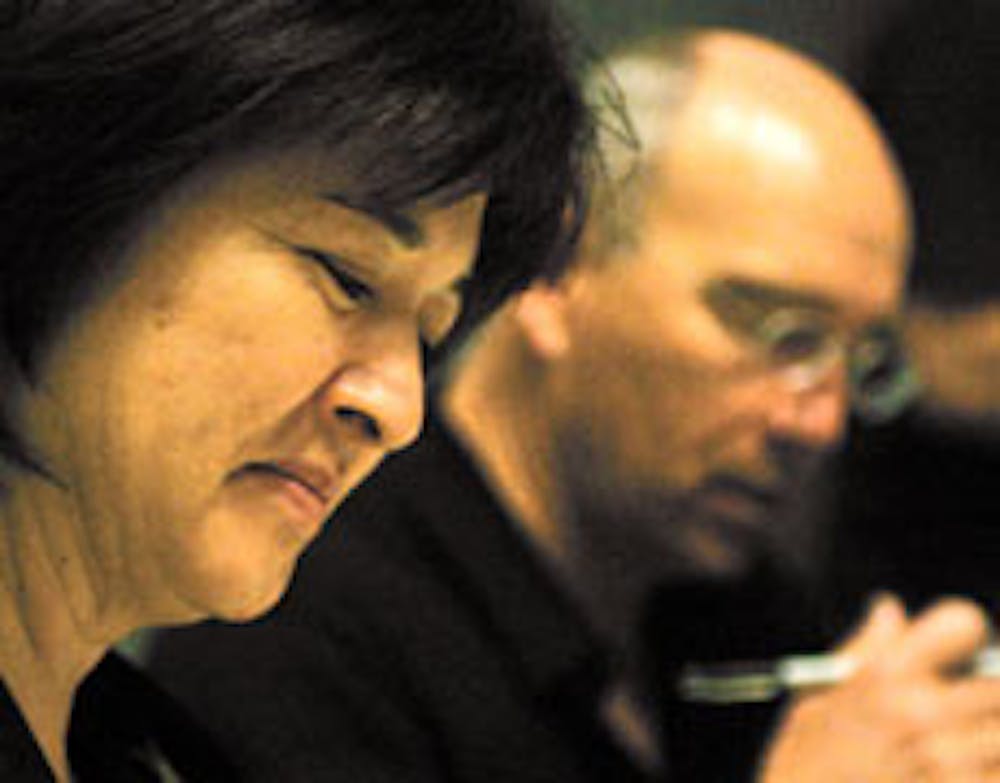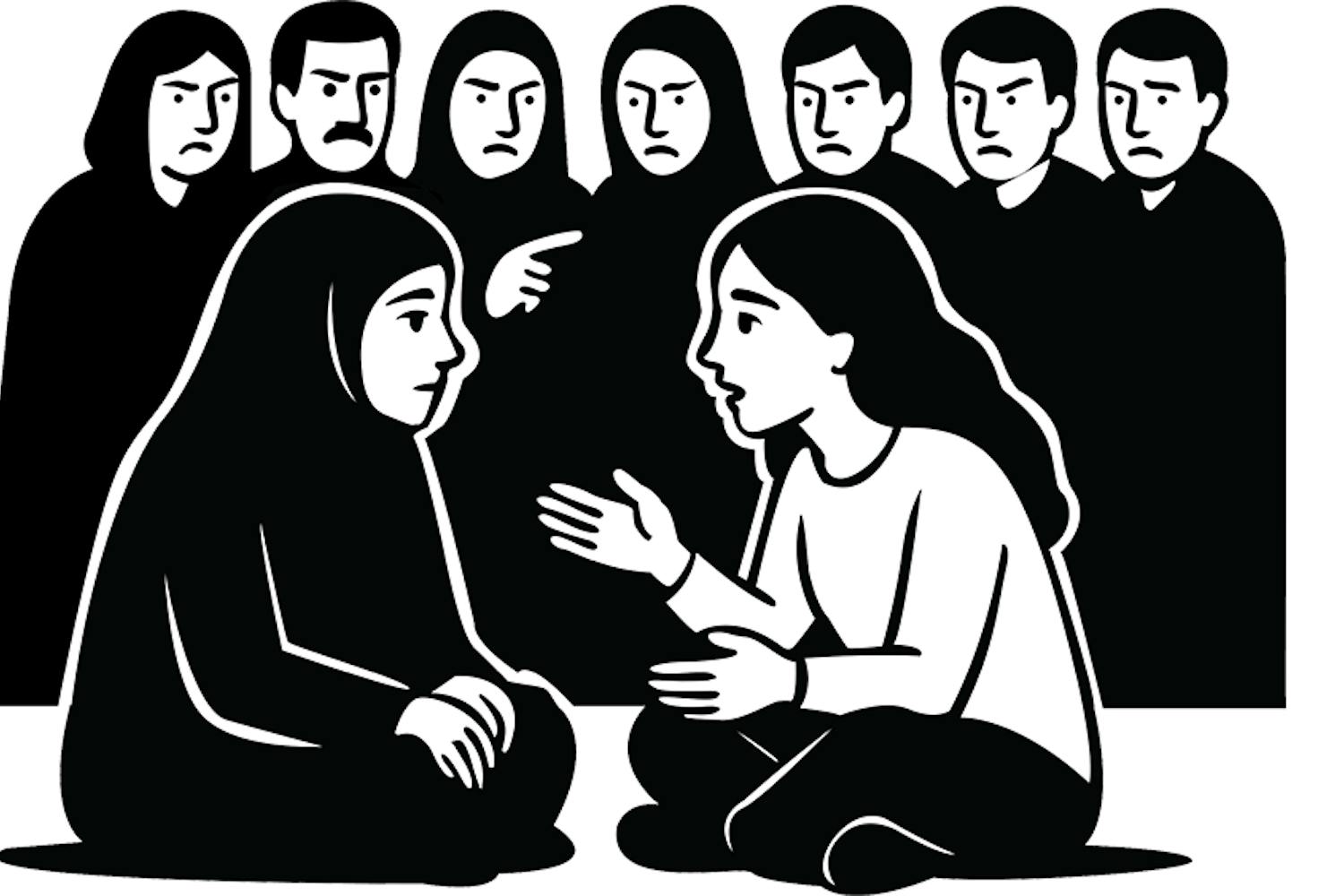One's art is often seen as self-defining--even with elites. Whether it's a sociopolitical expose or art, photography often serves as the lynchpin of a story. That is, the impact of a photograph commits readers to its surrounding text. For tenured National Geographic Photographers Karen Kasmauski and Sam Abell, their different approaches to photography elicit similar reactions. Tuesday night's exposition of their work hushed the audience with sober facts and softening comments.
Karen Kasmauski has shot photographs for National Geographic since 1984. Circumnavigating to Japan from Africa, Brazil and numerous other nations, her travels reflect the tone of her photographs. Kasmauski said editors and colleagues tell her she uses a sense of justice to formulate story ideas, which inevitably spill over into her work.
Her photographs step into parts of the world imaginations couldn't fathom. They snip nuances of beauty from the light that shines on the indigence. Kasmauski hones in on numerous issues, land issues surrounding old plantations in North Carolina, the secret lives of Japanese women, the lesser-known impact of Chernobyl and viruses across the world. While the average person may keel over in apathy, as do some when faced with imageless-words, Kasmauski's photographs titillate interest. With a photo of reindeer, the indirect repercussions of Chernobyl in Sweden tractor in judging eyes. A Brazilian child's eyes glint in a vaccine clinic, amidst an outbreak of yellow fever.
While radiation and viruses don't normally coincide with aesthetics, Kasmauski's expository photojournalism captures intense emotions stored in scenes words cannot paint. Glazed in angst, listlessness or jaundiced skin--these images elicit emotion reminiscent to museum art. Except this work is contextualized and concrete.
Kasmauski's work namely takes her to penurious nations plagued in problems: namely, Africa, Asia and South America. Naturally, one of them is insufficient health. Dark skin stretches over rib cages in beds while AIDS, rabies, yellow fever, dengue fever or cholera chomp away at life. Coupled with malnutrition, her images capture feelings transcending language's confines. Once exported back to wealthy nations, coffee table readers leaf through the unknowns, those at once terrible and beautiful snapshots of forlorn peoples.
An example of Kasmauski's graphical screaming out at Western readers is a shot of a Bangladeshi newborn, ready to be subjected to the whims of Third World healthcare. The photo appears on her new book, Impact: From the Frontlines of Global Health.
Indeed, the overall tone of Kasmauski's depictions is more political than artistic. She juxtaposed images of two overweight Caucasian men--one donning an adhesive American flag bathing suit--strolling a San Diego beach. Saying Americans consume 10 times more than other nations, eat more, she highlighted global inequity.
"If there is no money in Third World countries, there is no treatment," said Kasmauski.
Largely rooted in ethics, she said her work has origins in her working class background. Born to an eastern European father and Japanese mother, Kasmauski grew up immersed in disadvantage and with a desire to travel. This childhood experience exported her values into her work, which cooked a stew of human emotion felt in the dampened body heat of COOR 170.
In contrast, the global-issue exhibit yielded to Photographer Sam Abell's behind-the-scenes approach to photojournalism. While Kasmauski's portfolio examines specific issues, Abell's Tuesday presentation had autobiographical hues.
Abell opines his life is "a photographic life," filled with dichotomous emotions. Among them is a constant exposure to beauty while its opponent is loneliness. He said he wanted to live a life to inspire work as other work had done for him. In fact, few of the photographs Abell discussed were published in National Geographic. Rather, he rendered the process leading up to a published composition.
Unlike Kasmauski, Abell's life is immersed in photography, and has been since his birth. His father was a photographer at his high school, where Abell himself became a high school newspaper editor. Building on the skills inherited from his father, he encountered the major theme of his work at home. The major theme of much of the Midwest, he noted, is its flatness. A photograph his father snapped captured the horizon of his homogenous suburban villa. That horizon manifests in his best work.
Especially notable in Abell's portfolio are people, or animate objects that stray into the foreground. Animate people step into his foreground and his photo lives for a moment, and then only in a tangible memory. Abell said he nearly died three times in plane crashes, which he showed in three pictures. While gravity towed Abell's plane, he captured images of an Australian cyclone and lightening.
Photos flickered at patient ends allowed a worldwide tour of Abell's life, marked with projects coordinating with Historian Stephen Ambrose. More interesting than the pictures his father took to spice up family Christmas cards are those haunted by the horizon from his Ohio upbringing. His most popular exposure is a shot from Moscow's National Hotel. Taken in 1983, he passed a day photographing pears. The shot is a salad of wind, pear and the Old World, strange and familiar at the same time.
The artistic caprices and driving forces that fuel Abell's and Kasmauski's minds are those needed to expose the problems and beauty filling the world. Photography captures this interesting contrast, where rays of light saturate an Asian outhouse to make it stunning, while the facts around it only depress. This is the miracle of art in general, however. Fused together with media exposure, a picture speaking a thousand words stands a mere understatement.
Chris Kark is a reporter for the Web Devil. Reach him at christopher.kark@asu.edu.




